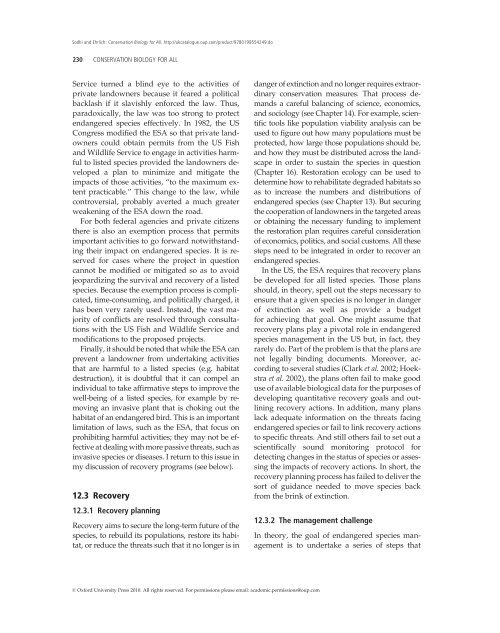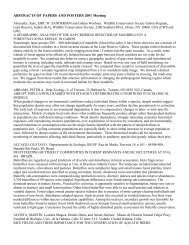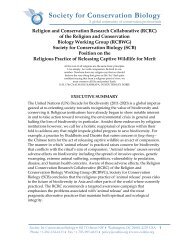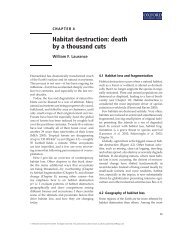Endangered species management: the US experience - Society for ...
Endangered species management: the US experience - Society for ...
Endangered species management: the US experience - Society for ...
You also want an ePaper? Increase the reach of your titles
YUMPU automatically turns print PDFs into web optimized ePapers that Google loves.
Sodhi and Ehrlich: Conservation Biology <strong>for</strong> All. http://ukcatalogue.oup.com/product/9780199554249.do<br />
230 CONSERVATION BIOLOGY FOR ALL<br />
Service turned a blind eye to <strong>the</strong> activities of<br />
private landowners because it feared a political<br />
backlash if it slavishly en<strong>for</strong>ced <strong>the</strong> law. Thus,<br />
paradoxically, <strong>the</strong> law was too strong to protect<br />
endangered <strong>species</strong> effectively. In 1982, <strong>the</strong> <strong>US</strong><br />
Congress modified <strong>the</strong> ESA so that private landowners<br />
could obtain permits from <strong>the</strong> <strong>US</strong> Fish<br />
and Wildlife Service to engage in activities harmful<br />
to listed <strong>species</strong> provided <strong>the</strong> landowners developed<br />
a plan to minimize and mitigate <strong>the</strong><br />
impacts of those activities, “to <strong>the</strong> maximum extent<br />
practicable.” This change to <strong>the</strong> law, while<br />
controversial, probably averted a much greater<br />
weakening of <strong>the</strong> ESA down <strong>the</strong> road.<br />
For both federal agencies and private citizens<br />
<strong>the</strong>re is also an exemption process that permits<br />
important activities to go <strong>for</strong>ward notwithstanding<br />
<strong>the</strong>ir impact on endangered <strong>species</strong>. It is reserved<br />
<strong>for</strong> cases where <strong>the</strong> project in question<br />
cannot be modified or mitigated so as to avoid<br />
jeopardizing <strong>the</strong> survival and recovery of a listed<br />
<strong>species</strong>. Because <strong>the</strong> exemption process is complicated,<br />
time-consuming, and politically charged, it<br />
has been very rarely used. Instead, <strong>the</strong> vast majority<br />
of conflicts are resolved through consultations<br />
with <strong>the</strong> <strong>US</strong> Fish and Wildlife Service and<br />
modifications to <strong>the</strong> proposed projects.<br />
Finally, it should be noted that while <strong>the</strong> ESA can<br />
prevent a landowner from undertaking activities<br />
that are harmful to a listed <strong>species</strong> (e.g. habitat<br />
destruction), it is doubtful that it can compel an<br />
individual to take affirmative steps to improve <strong>the</strong><br />
well-being of a listed <strong>species</strong>, <strong>for</strong> example by removinganinvasiveplantthatischokingout<strong>the</strong><br />
habitat of an endangered bird. This is an important<br />
limitation of laws, such as <strong>the</strong> ESA, that focus on<br />
prohibiting harmful activities; <strong>the</strong>y may not be effective<br />
at dealing with more passive threats, such as<br />
invasive <strong>species</strong> or diseases. I return to this issue in<br />
my discussion of recovery programs (see below).<br />
12.3 Recovery<br />
12.3.1 Recovery planning<br />
Recovery aims to secure <strong>the</strong> long-term future of <strong>the</strong><br />
<strong>species</strong>, to rebuild its populations, restore its habitat,<br />
or reduce <strong>the</strong> threats such that it no longer is in<br />
danger of extinction and no longer requires extraordinary<br />
conservation measures. That process demands<br />
a careful balancing of science, economics,<br />
and sociology (see Chapter 14). For example, scientific<br />
tools like population viability analysis can be<br />
used to figure out how many populations must be<br />
protected, how large those populations should be,<br />
and how <strong>the</strong>y must be distributed across <strong>the</strong> landscape<br />
in order to sustain <strong>the</strong> <strong>species</strong> in question<br />
(Chapter 16). Restoration ecology can be used to<br />
determine how to rehabilitate degraded habitats so<br />
as to increase <strong>the</strong> numbers and distributions of<br />
endangered <strong>species</strong> (see Chapter 13). But securing<br />
<strong>the</strong> cooperation of landowners in <strong>the</strong> targeted areas<br />
or obtaining <strong>the</strong> necessary funding to implement<br />
<strong>the</strong> restoration plan requires careful consideration<br />
of economics, politics, and social customs. All <strong>the</strong>se<br />
steps need to be integrated in order to recover an<br />
endangered <strong>species</strong>.<br />
In <strong>the</strong> <strong>US</strong>, <strong>the</strong> ESA requires that recovery plans<br />
be developed <strong>for</strong> all listed <strong>species</strong>. Those plans<br />
should, in <strong>the</strong>ory, spell out <strong>the</strong> steps necessary to<br />
ensure that a given <strong>species</strong> is no longer in danger<br />
of extinction as well as provide a budget<br />
<strong>for</strong> achieving that goal. One might assume that<br />
recovery plans play a pivotal role in endangered<br />
<strong>species</strong> <strong>management</strong> in <strong>the</strong> <strong>US</strong> but, in fact, <strong>the</strong>y<br />
rarely do. Part of <strong>the</strong> problem is that <strong>the</strong> plans are<br />
not legally binding documents. Moreover, according<br />
to several studies (Clark et al. 2002; Hoekstra<br />
et al. 2002), <strong>the</strong> plans often fail to make good<br />
use of available biological data <strong>for</strong> <strong>the</strong> purposes of<br />
developing quantitative recovery goals and outlining<br />
recovery actions. In addition, many plans<br />
lack adequate in<strong>for</strong>mation on <strong>the</strong> threats facing<br />
endangered <strong>species</strong> or fail to link recovery actions<br />
to specific threats. And still o<strong>the</strong>rs fail to set out a<br />
scientifically sound monitoring protocol <strong>for</strong><br />
detecting changes in <strong>the</strong> status of <strong>species</strong> or assessing<br />
<strong>the</strong> impacts of recovery actions. In short, <strong>the</strong><br />
recovery planning process has failed to deliver <strong>the</strong><br />
sort of guidance needed to move <strong>species</strong> back<br />
from <strong>the</strong> brink of extinction.<br />
12.3.2 The <strong>management</strong> challenge<br />
In <strong>the</strong>ory, <strong>the</strong> goal of endangered <strong>species</strong> <strong>management</strong><br />
is to undertake a series of steps that<br />
© Ox<strong>for</strong>d University Press 2010. All rights reserved. For permissions please email: academic.permissions@oup.com






